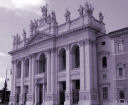Most of us who live now think of the Last Supper in terms that are familiar to us. In our imagination Jesus and his apostles sit around a square table on chairs. Jesus is a the center and his apostles arrayed around him. The famous painting of Leonardo Da Vinci (See right) is uppermost in most modern minds when thinking of the Last Supper.
But the real Last Supper was different in many significant ways.
Some of the following I am about it present is still a matter of debate other aspects of it are undisputed.
1. Jesus and the Apostles did not sit on chairs at a table. Rather they reclined on ground or on mats and pillows, leaning on their left elbow (leaning either forward or on their left side) and eating with their right hand. Their legs were stretched out behind them. (See picture at left, click to get a bigger size) This was the typical fashion for eating in the ancient world. That they reclined to eat is made plain in the Gospel of Mark: While they were reclining at the table eating, he said, “I tell you the truth, one of you will betray me–one who is eating with me (Mk 14:18).
This setting also explains some things that seem strange to us moderns. First of all why did John lean back on Jesus’ chest to ask him a question? (Jn 13:25; 21:20) This would be strange and physically awkward in a modern upright table setting. But reclining on one’s side on a mat meant you had to lean back to talk to the person next to you. Thus, while many see the act as a tender one, it may also have had a practical dimension.
There is also explained another strange scene (to us moderns) where Jesus is reclining to eat in the home of a Pharisee and and a woman begins to anoint his feet (Luke 7:38). In a modern upright table setting this would mean she’d have to be under the table. Strange indeed! But in the ancient setting, the posture was such that one’s feet were behind and thus the woman could approach Jesus from behind and begin to anoint his feet without his prior knowledge.
2. The Place of honor in modern western settings at a typical long rectangular table is either at the center or at one end. Everyone is seated upright and facing in to the center and can generally see all the others well. However, in the ancient meal setting the table was “U” shaped, either as a half circle, or with 90 degree arms. Instead of sitting at the center of the table (as in DaVinci’s painting above) the host or honored guest sat at one corner. Further, everyone sat on one side on the outside of the table allowing the inside of the table to open for servers.
The picture to the right is from a very early mosaic in Ravenna, probably made well before the 5th Century. At this early time, artists still had access to more of the memory of the actual practices at the time of Jesus and thus depicts the Last Supper as it was more likely arranged. Notice that Jesus is at the head of the corner and his disciples are arrayed in a sloping ark behind and sloping to his left. This was the usual setting for the ancient meal and especially something as formal as a passover meal.
It would seem however, for John to have been able to lean back on Jesus’ chest to ask him the question, that Jesus would have to been on the opposite side of the “table” from that depicted in the Ravenna mosaic. But we still get the basic point of what ancient meal settings looked like.
3. It would seem (though this is debatable) that the place of second honor was at the other end of the U shaped table on the opposite corner. This would help explain why Peter is not at Jesus’ immediate side and has to motion to John across the room to lean back and ask Jesus a question (Jn:13:24-25). Since Peter would like have had the other place of honor it makes sense that he would be across the room and unable to ask Jesus himself.
Here too the Ravenna Mosaic seems instead to picture Peter right next to the Lord, which would not comport with the likely biblical evidence that John was in fact to the Lord’s right. But the mosaic does capture well the reclining at a U shaped low table.
Thus the whole setting of the Last Supper was rather a different setting that most modern people imagine. Leaning on elbows and eating with one hand would all be very awkward to us. But I suppose they’d think what we do strange as well. Nevertheless, the ancient practice, DaVinci and modern notions notwithstanding was that people reclined to eat.
The following clip is a humorous scene from the Passion of the Christ. Mary is puzzled over Jesus making a tall table to eat at. She cannot imagine that anyone would want to eat sitting up. She says, “This will never catch on!”


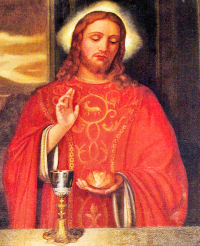
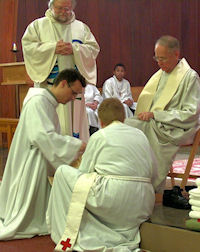 During the evening of Holy Thursday, the Mass of the Lord's Supper is celebrated. It is celebrated in the evening because the Passover began at sundown. There is only one Mass, at which the whole community and priests of the parish participate. This is a very joyful Mass, as we recall the institution of the Holy Eucharist and the priesthood. The priests wear white vestments, the altar is filled with flowers, the Gloria is sung and the bells are rung. After the Gloria, we shall not hear organ music and the bells until the Easter Vigil. The Liturgy of the Mass recalls the Passover, the Last Supper, which includes the Washing of the Feet. The hymn Ubi Caritas or Where Charity and Love Prevail is usually sung at this time. After the Communion Prayer, there is no final blessing. The Holy Eucharist is carried in procession through Church and then transferred into a place of reposition, usually a side chapel. The hymn Pange Lingua is also usually sung at this time.
During the evening of Holy Thursday, the Mass of the Lord's Supper is celebrated. It is celebrated in the evening because the Passover began at sundown. There is only one Mass, at which the whole community and priests of the parish participate. This is a very joyful Mass, as we recall the institution of the Holy Eucharist and the priesthood. The priests wear white vestments, the altar is filled with flowers, the Gloria is sung and the bells are rung. After the Gloria, we shall not hear organ music and the bells until the Easter Vigil. The Liturgy of the Mass recalls the Passover, the Last Supper, which includes the Washing of the Feet. The hymn Ubi Caritas or Where Charity and Love Prevail is usually sung at this time. After the Communion Prayer, there is no final blessing. The Holy Eucharist is carried in procession through Church and then transferred into a place of reposition, usually a side chapel. The hymn Pange Lingua is also usually sung at this time. 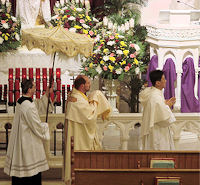 When the Eucharist is processed to the altar of repose after the Mass of the Lord's Supper, we should remain in quiet prayer and adoration, keeping Christ company. There is a tradition, particularly in big cities with many parishes, to try and visit seven churches and their altar of repose during this evening.
When the Eucharist is processed to the altar of repose after the Mass of the Lord's Supper, we should remain in quiet prayer and adoration, keeping Christ company. There is a tradition, particularly in big cities with many parishes, to try and visit seven churches and their altar of repose during this evening. 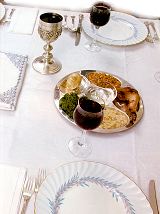 In imitation of Christ's last supper, many Christians prepare a seder meal or the pasch. Celebrating a paschal meal helps us comprehend the plan of redemption. We see the lamb, cooked whole, with no bones broken, foreshadowing the death of Christ, the Lamb of God. We eat the unleavened bread and recall to mind the Eucharist. We eat the whole meal in prayerful reminder of that Last Supper that Jesus spent with His apostles, His friends, instituting Holy Orders and leaving His greatest gift, the Holy Eucharist.
In imitation of Christ's last supper, many Christians prepare a seder meal or the pasch. Celebrating a paschal meal helps us comprehend the plan of redemption. We see the lamb, cooked whole, with no bones broken, foreshadowing the death of Christ, the Lamb of God. We eat the unleavened bread and recall to mind the Eucharist. We eat the whole meal in prayerful reminder of that Last Supper that Jesus spent with His apostles, His friends, instituting Holy Orders and leaving His greatest gift, the Holy Eucharist. 